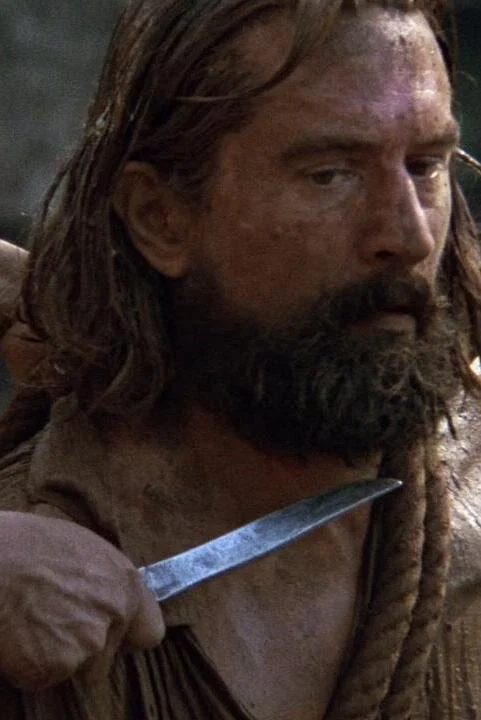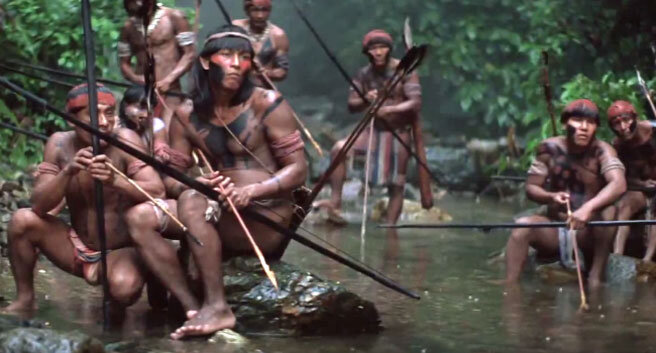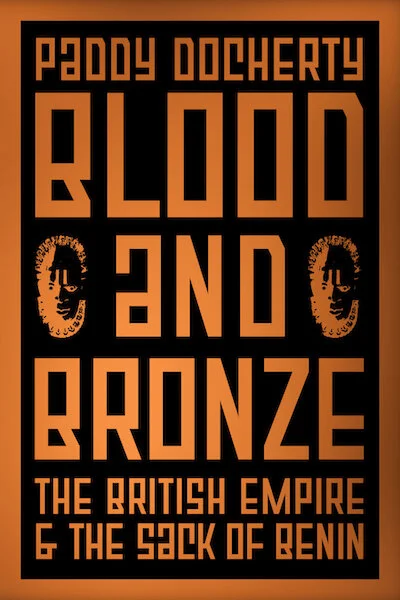Empire Film: ‘The Mission’ and the colonisation of history
It is easy for us to identify and dismiss the old and clunky Empire films of a previous era – Sanders of the River or the Zoltan Korda version of the The Four Feathers, for example. We can stare wide-eyed at their amazing racism and crazy ideals, and laugh in derisive astonishment. When, however, empire strikes back in the form of a beautifully filmed recent production, featuring film stars that rank among the favourites of our own era, the colonial messaging is typically much less evident.
This is especially the case when the movie is an avowedly progressive project and has received the endorsement of a Palme d’Or from Cannes. The Mission – a visually fabulous film from 1986, starring Jeremy Irons and Robert De Niro – is one such work. On the face of it, it sells itself as a liberal tale of anticolonialism and religious inspiration, but a look under the surface reveals a disturbing erasure of indigenous people and a fundamental prioritising of white narratives and voices.
Jesuit missions, high politics and the Guaraní War
Set in the Rio de la Plata region of South America, the film is very loosely based on the events surrounding the Guaraní War of 1756. In the Treaty of Madrid of 1750, Spain and Portugal (the two European colonising powers in the area) came to an agreement over certain borders in what are now Argentina and Brazil. Under the terms of this treaty, seven Jesuit mission settlements east of the Uruguay River would be handed over to Portugal and the residents – mainly from the Guaraní people, who had dominated the region from prehistoric times – were given the option of leaving for other Spanish territory or remaining and coming under Portuguese rule. The mission Guaraní had lived in the settlements for well over a century, and had developed them into flourishing agribusiness operations. In no mood to surrender what they had built, they instead chose resistance and took up arms. Two years of sporadic campaigning eventually led to them being destroyed by a joint Spanish-Portuguese army at the Battle of Caiboaté in February 1756.
Guaraní: entirely silenced by the movie producers
Reframing the story
In the film, however, things are very different. It opens with one Cardinal Altamirano (who serves as our narrator through the device of dictating a letter to the Pope). He sets up a false notion that the story is one of the church allying with the ‘Indians’ against the colonial powers – a misleading note which prefigures one of the central lies of the whole enterprise, which comes later in the film.
The Cardinal also utters some patronising gibberish about how “the noble souls of these Indians incline towards music…”. There is no evident basis for this claim, which seems to be related only to the desire of the filmmakers to arm Jeremy Irons with an oboe, as a clumsy contrast to the weapons of the men of violence, and presumably also in order to maximise the use of the stunning score from Ennio Morricone.
While the Cardinal drones on in voiceover, we are taken to the jungle ‘above the falls’, a region as yet largely untouched by Europeans and still the domain of the dangerous ‘Indians’. We see them capture a Jesuit, tie him to a crude wooden crucifix, and launch him into a river. He floats downstream, providing fabulous visuals (the film won an Academy Award for cinematography), as we gradually realise that he is approaching a waterfall. Eventually, the camera pulls back to reveal the magnificent Iguazu Falls, as the crucifix tumbles over the edge and the Jesuit plummets to his death. It’s an astounding image and makes for great cinema – not surprisingly, it appeared on many of the posters when the film was released in 1986.
It’s a very striking visual, but is utterly invented. No such incident has ever been recorded of a missionary (or anyone else) being trussed up and floated over the falls. Devised purely for cinematic reasons, it is in fact a gross misuse of powerful imagery, as it promotes false narratives of the Guaraní as casually murderous, and of Jesuits as sympathetic, photogenic martyrs.
A white saviour and his magical oboe
As a direct consequence of this fictional martyrdom, the Cardinal-narrator introduces the solution to ‘Indian’ barbarism: our white saviour, Jeremy Irons, bearing his magical oboe. We see this beatific Jesuit set off – nobly alone, for reasons never explained – and follow his not-wholly-convincing heroic paddle up a raging river in his tiny canoe. We watch him climb barefooted up the great falls, with his symbolic musical instrument slung across his back like a rifle. Despite the usual cinematic perils, he makes it successfully into Guaraní territory.
In one of the most ludicrous moments in a film full of them, we then see Jeremy promptly sit down on a log, whip out his oboe, and start playing a little tune. Magically, and insultingly, curious and apparently music-loving Guaraní gather around him within minutes. A montage later and they’re all converted to Catholicism; in possibly the most retch-worthy line of the whole film, we hear the Cardinal-narrator declare that “with an orchestra the Jesuits could have subdued the whole continent”.
A villain appears while the Guaraní (and women) are marginalised
Once Jeremy has been firmly established as the Guaraní’s new spiritual leader (and, apparently, town planner-cum-social director), the tone of the film suddenly shifts. Robert De Niro arrives on screen, playing Captain Mendoza, a slaver and, we are told, ‘mercenary’, which seems to be simply code for ‘bad guy’. We see him seizing some Guaraní and shooting others (somewhat implausibly, since they in fact represent valuable merchandise to someone in his line of business…). Thus through the swift deployment of a few movie tropes, it is quickly established that he is our villain.
Throughout this movie, the Guaraní are patronised and insulted, but what happens when Captain Mendoza appears is one of the worst incidences of reducing and infantilising them, while elevating the white presence. On being attacked by Mendoza, the response of the movie Guaraní is to run to Jeremy Irons, as toddlers run to their mothers. They cluster around him, pleading for protection. This is despite the fact that even the movie Guaraní are well-armed and have their own leaders; in historical reality, they had been fighting off slavers and settlers for 130 years by this time, so it does not seem plausible that they couldn’t handle a single Robert De Niro…
Captain Mendoza then returns to the city and, in brief, kills his own brother in a jealous rage. Cherie Lunghi plays the disputed love interest, and this is her only function in the movie; there is literally no female agency in the entire film, and almost no female lines in the script. The only other women I can recall are a handful of the bare-breasted but silent Guaraní women that National Geographic has apparently conditioned most people to expect in this kind of setting.
Guaraní as mute vehicles for white redemption
After murdering his brother, Mendoza spends a few months in a virtually catatonic state of funk. Jeremy Irons, on a visit to the city, is apparently the only person who can help, and is summoned to talk to the suicidal villain. Mendoza follows him back to the new mission above the falls, where once he hunted slaves; as penance, he must drag behind him a giant bundle of his weapons and armour, and the camera labours on him, indulging him in his guilt. Once again, the film prioritises the white experience, as if we are expected automatically to care about Mendoza and his fratricidal torments, in preference to the numerous Guaraní whom he has also murdered but who get no second thoughts.
Robert De Niro as Mendoza, with unnamed Guaraní
This brings us to a clunky but unintentionally revealing moment. They arrive at the new mission, and the Guaraní of course recognise Mendoza as the slaver who has made a career of pursuing them; one angry Guaraní takes a knife and threatens to cut his throat (see picture). Jeremy Irons talks (in Guaraní ) to an unnamed Guaraní who appears to be some sort of chief. The unnamed chief then speaks to the knife wielding man (also unnamed), who cuts the rope connecting the bundle to Mendoza, instead of slitting his throat, thus symbolically forgiving him. No doubt the filmmakers were pleased with this sequence, though it strikes an objective viewer as horribly clumsy.
The revealing part is not the ‘forgiveness’, but the fact that the filmmakers do not bother to translate the Guaraní language. Despite the apparently crucial nature of the conversation between Jeremy and the chief, the viewer learns nothing of what was said. Nowhere in the film is the Guaraní language translated; since none of the Guaraní speak English at any point, they have been quite literally silenced.
Once Mendoza has been accepted by the Guaraní, we see lots of mission-building in montage, involving shirtless carpentry, smiling children and the usual warm footage of dancing and laughing etc. Mendoza gets a tribal tattoo and laughs with some semi-naked women. We see him hunt with some youths and pratfall good-naturedly. He officially becomes a Jesuit brother. The viewer will note that the narrative has become entirely about the spiritual journey of this one errant white man; the Guaraní are made passive vehicles for his redemption.
High politics intrudes, and the most flagrant lie of the film
To cut a long and painful story short, high politics intrudes into this movie jungle paradise and the Jesuits are ordered to hand over the mission to the Portuguese. Jeremy Irons will stay with the Guaraní but refuses to fight; Mendoza decides to take up arms to defend the mission, and begins to organise the Guaraní for defence. A young boy dives into the river and retrieves the bundle of arms, symbolically (and clumsily) announcing Mendoza’s return to a life of violence. A Spanish-Portuguese army arrives at the mission and Mendoza leads the Guaraní in a desperate battle; Jeremy Irons is equally heroic but in a non-violent way, photogenically and pointlessly leading a peaceful crowd of church celebrants to be cut down by musket fire. The film ends with the mission destroyed, and Jeremy Irons and Mendoza both dead. It is visually spectacular, and of course a complete fiction.
Comic book Sepé Tiaraju
This is the most flagrant lie of the film. In historical reality, the Jesuits abandoned the missions in 1754 as instructed, following the Treaty of Madrid. Quite apart from being led by a white slaver in search of redemption, the Guaraní had their own leadership during the war against the colonisers: during the 1754-56 campaign, they were ably led by Sepé Tiaraju, a Guaraní hero who is celebrated to this day (see pictures). He held off Spanish and Portuguese forces in 1754, and then agreed an armistice with them. Fighting resumed in early 1756, and he was killed in a skirmish three days before the final battle at Caiboaté. The erasure of Guaraní leadership and their replacement with fictional white interlopers is one of the most indefensible features of this movie. No Jesuits died at Caiboaté. Sepé Tiaraju must be restored to the story.
Mural of Sepé Tiaraju in Porto Alegre, Brazil
Brutal colonisation of the Guaraní story
The Mission begins with shameless dishonesty: its opening title card reads “The historical events represented in this story are true…”, which is manifestly false. Not only have specific facts been altered or abandoned, the film misrepresents the past so flagrantly that it is true to neither the letter nor the spirit of the story it claims to tell. Why the filmmakers did not simply employ the usual ‘inspired by true events’ get-out clause is beyond understanding, but they must be roundly condemned for making this bold claim to historical legitimacy, since the film does violence to the very people they supposedly support and defend. By stripping the Guaraní of agency and erasing their historical leadership, The Mission infantilises and reduces them. It inserts white saviours into the narrative and prioritises their private concerns. It literally silences Guaraní voices. In these ways, the film is a brutal colonisation of the Guaraní story. Its gross distortion of history demands to be rectified.
The Mission, 1986, directed by Roland Joffé and written by Robert Bolt. Produced by Fernando Ghia and David Puttnam for Goldcrest Films/Warner Brothers. 125 mins.






